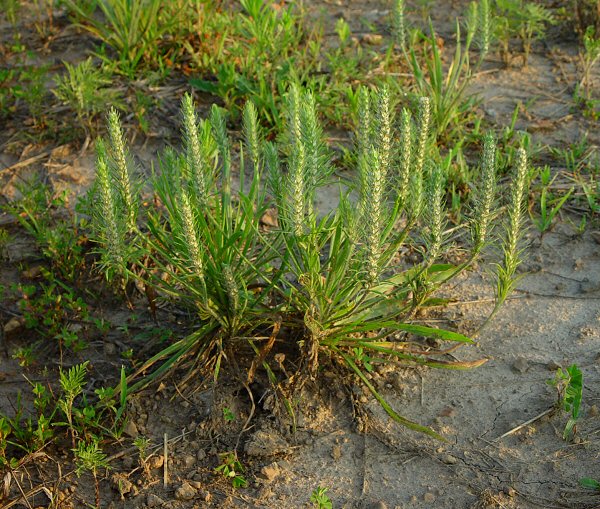Plantago aristata Michx.
Bracted Plantain

Native
CC = 1
CW = 5
MOC = 85
© DETenaglia
Plantago aristata Michx.Bracted Plantain | |
 |
Native CC = 1 CW = 5 MOC = 85 |
© DETenaglia |
|
Family - Plantaginaceae Habit - Taprooted annual forb.
Stems - Aerial stems absent or very short and inconspicuous (to 3 cm long with age), then ascending to erect, unbranched or rarely with a basal branch. Leaves - In a dense basal rosette, alternate but crowded on stem, sessile or with a short, poorly differentiated petiole, strongly ascending. Leaf blades 3-17 cm long, 1-7 mm wide, linear or narrowly oblanceolate, angled or tapered to a sharply pointed tip, long-tapered at the base, the margins entire or occasionally with a few inconspicuous teeth toward the base, hairy, the upper surface glabrous, usually appearing dark green, the undersurface moderately to densely pubescent with shaggy or woolly hairs, appearing uniformly gray, with 1 main vein.
Inflorescence - Terminal, elongate spikes, 1 to several per plant, 3-15 cm long 7-15 mm in diameter (excluding the bracts), densely flowered (the axis not visible between the flowers), the stalk 2-25 cm long, hairy, the axis solid. Lowermost bracts 10-30 mm long, becoming progressively shorter toward the spike tip, all or most extending past the flowers, linear above a short, inconspicuous, translucent pair of basal wings, long-tapered to the loosely ascending to somewhat arched tip, hairy, more densely so on the undersurface. Cleistogamous flowers usually abundant.
Flowers - Calyces deeply 4-lobed, 2.0-2.5 mm long, slightly zygomorphic, the lobes narrowly oblong-obovate, rounded at the tip, the upper pair with somewhat broader, papery margins than the lower pair. Corollas more or less zygomorphic, the lobes 1.4-2.5 mm long, broadly ovate with a shallowly cordate base, rounded at the tip, the margins entire, each with an inconspicuous brown base, otherwise white to somewhat translucent, the upper lobe slightly shorter than the others and ascending at flowering, the other lobes spreading, spreading to reflexed after flowering. Stamens 4, the anthers somewhat heart-shaped.
Fruits - Capsules 2.8-3.5 mm long, ellipsoid to ovoid, circumscissile just below the midpoint. Seeds usually 2 per fruit, 2-3 mm long, oblong-elliptic, the surface deeply concave on 1 side, otherwise relatively smooth, reddish brown to brown, with a pair of lighter longitudinal stripes on either side of the concave portion. Flowering - May - November. Habitat - Glades, savannas, prairies, forest openings, ledges and tops of bluffs, streambanks, pastures, fields, railroads, roadsides, open disturbed areas. Origin - Native to the U.S. Lookalikes - None close. Other info. - This species can be found throughout nearly all of Missouri, possibly excepting the northwest corner of the state. Beyond Missouri it ranges across most of the eastern half of the continental U.S., with sporadic and widely scattered populations in more western areas of the country. Interestingly, despite being native it is considered a noxious weed in several southern states. The plant is easy to identify due to its long, awned bracts, which give the inflorescences a distinctive appearance. The size of the plant is quite variable and occasional specimens may have poorly developed bracts. Photographs taken at the Dave Rock Conservation Area, St. Clair County, MO., 6-7-03, and in Springfield, MO., 7-5-03 (DETenaglia); also at Shaw Nature Reserve, Franklin County, MO, 7-17-2015, Canaan Conservation Area, Gasconade County, MO, 6-28-2016, and Klondike County Park, St. Charles County, MO, 6-11-2022 (SRTurner). |